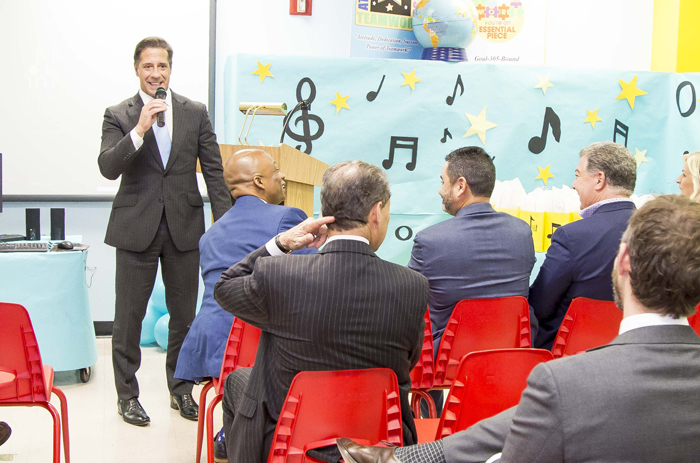A one-to-one program needs to be linked to the academic goals of the district, and everyone needs to support the effort, from the chief academic officer who sets the academic vision to the CFO who figures out how to finance the effort and the chief of police who makes sure kids are safe when they carry devices to and from school. It all boils down to extensive, excruciating planning.
MORE FROM EDTECH: What should administrators be thinking about when integrating new technology.
EDTECH: How did your district prepare its infrastructure for digital access?
Carvalho: Preparing infrastructure for digital access is critical. You can’t have all of the vehicles on the road and not enough lanes to support them. Nobody wants digital gridlock.
We established full wireless capabilities in our district and all of our schools prior to starting the device rollout. We have more than 45 million square feet of space that now has very powerful wireless access across the district.
We also upgraded our network infrastructure, which needed not only new equipment but also a bigger pipe to support the additional traffic. Each year we’ve added additional access points at all schools as we’ve added additional devices, and we continue to increase our bandwidth.
EDTECH: How important is it to include the IT team in technology decisions?
Carvalho: I think it’s key. The IT team is indispensable in the crafting of the plan. In our district, we made decisions to deploy devices where it made sense instructionally and where digital materials were widely available.
The academic staff worked hand in hand with the IT team as decisions were made about devices, tools and processes for managing the environment. The decision-making process needs to be driven by the academic goals of the district and clearly, aggressively informed by IT specialists.
EDTECH: Were you able to use E-rate funding?
Carvalho: E-rate was essential to building out our wireless infrastructure. It didn’t cover all the schools because of the free and reduced threshold, but it got us about two-thirds of the way there.

Superintendent Alberto Carvalho says equity and inclusion are paramount in Miami-Dade County Public Schools. Photography by: Josh Ritchie.
We also did a very aggressive fundraising campaign to generate part of the match requirement. Former Miami Heat player Alonzo Mourning helped us bring in about $7 million to draw down close to $70 million in E-rate investment.
MORE FROM EDTECH: See how schools are taking advantage of category one E-rate funding.
EDTECH: What is your advice to school districts that haven’t yet taken advantage of E-rate funds?
Carvalho: Pursue it. You have cards to play; play them all. Before you decide to jump on E-rate or other means of financing your efforts, develop your plan — not just first-year costs, but multiyear costs, including one-time investments and recurring liabilities — and then use all the cards you have available to you.
E-rate is, quite frankly, indispensable, particularly for districts where the student profile is economically disadvantaged. It is a card that absolutely must be played.
EDTECH: How important is it to consider diversity, equity and inclusion in technology decisions?
Carvalho: That’s the North Star in everything we do. Our project here is all about digital access and equity. We didn’t pilot to select schools, but instead deployed districtwide from day one. Following the theory of action, if it’s good for some, it ought to be good for everyone now, not sequentially.
EDTECH: You’ve said before that access to technology used to be viewed as a privilege, but now it’s a right. How so?
Carvalho: Students can’t get a relevant, well-balanced education that really prepares them for postsecondary learning or the workforce without K–12 learning opportunities that involve the use of technology.
Teaching students to use technology to solve problems, to communicate effectively, to collaborate with others, to engage in teamwork is crucial to their own development and strengthens their 21st-century skills. Using technology really ensures that students have an advantage in our global society, with global workforce requirements.
If you do not allow, encourage or enable students to cross the threshold where technology is really environmental in classrooms, then you’re doing students a disservice. Technology today is not an add-on or an optional component of classroom instruction. It is embedded as part of the fabric of a new way of teaching and a new way that students connect to learning and to information.
Disconnecting them from that is really disconnecting them from opportunities. Students in any school or district, regardless of ZIP code or economic situation, deserve to have access to the tools that will prepare them for the future.
EDTECH: Have you experienced firsthand how technology helps students get a superior education?
Carvalho: I grew up in abject poverty, so through that lens I see myself in a lot of kids in our school systems across America. I’ve seen the needle of academic performance move aggressively when school leaders and teachers leverage technological tools and digital content that are personalized and adaptive, particularly with students in underserved communities.
It was a game changer to see students have a tool that they can take home with a wireless card, creating an opportunity for instruction beyond the last bell of school. There was also a collateral benefit that, quite frankly, we did not anticipate up front — the device itself became a portal of exciting learning for the parents too.
One of the most significant investments that we made, second only to our investment in teacher effectiveness, was the investment in technology and the investment in the personalization of education. I saw it with my own eyes, particularly in some of the most impoverished elementary schools in our district — teaching came alive.
I saw students interacting with the teacher using their own devices. Seeing their work product reflected on the whiteboard in real time was magical. To have that then accompany the child home and create a portal of opportunity for the entire family was really transformational.
EDTECH: What would you tell district leaders who want to undergo a digital transformation but don’t know where to begin?
Carvalho: Start slow, but plan fast. Plan aggressively, but be deliberate and methodical in your deployment. Establish realistic, scalable goals. Let these goals drive the plan for your transformation. Assess your needs and the skill set of your employees.
You never want to be in a position where you have great tools, but your own workforce has inadequate skills to manage them. And understand that your employees’ technological skills will be a factor in the logistics of the deployment itself.
Have a robust professional development plan. Target the willing. Offer a lot of ongoing training and develop a plan to scaffold your PD from year to year based on employees’ abilities and where you ultimately want them to be.
And one thing I often tell folks, have fun at it. Engage the community in the excitement of bringing technological tools their ZIP codes.











